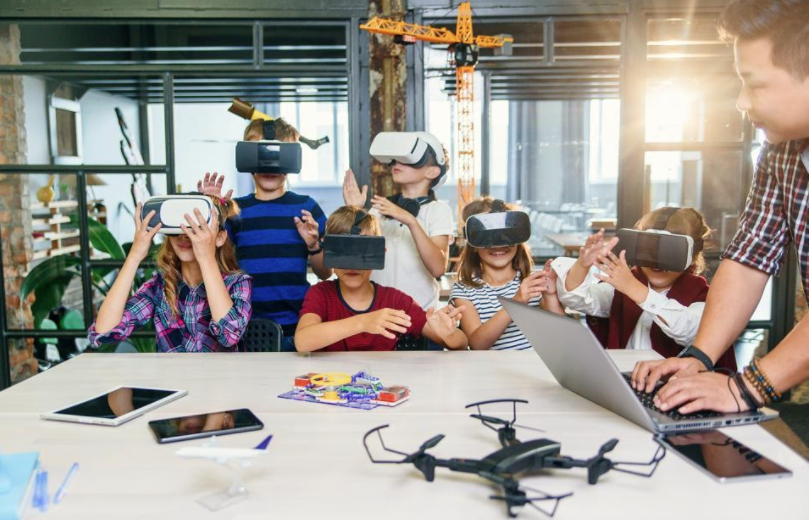The 5 Ways VR and AR Will Change The Way We Learn At School, At Work And In Our Personal Lives
It’s fair to say that a lot of teaching is based on presenting students with facts. This means successful students tend to be those who retain facts easily, while students who struggle to process large amounts of information at one time can quickly become disengaged. This arguably applies to all types of learners, whether it’s in a school setting, on a workplace training course, or in lifelong learning.

Some people are visual learners, after all, which means the ability to “see” a process (rather than read or hear about it) is far more impactful for them. This is where virtual reality (VR) and augmented reality (AR) can add real value to the learning process. These “extended reality” (XR) technologies can create immersive worlds where students can visualize concepts and learn new skills and information in an interactive way.
Here are five ways VR and AR could transform education.
- Creating a more immersive experience for schoolchildren
Thanks to its highly immersive nature, VR can transport students to different places, and even different times. One great example comes from 1943: Berlin Blitz, a VR experience produced for the BBC by Immersive VR Education. Recreating the events that took place on September 3rd 1943, this experience portrays the true story of a Lancaster Bomber on a mission to Berlin.
Alongside the regular crew, the plane was also carrying BBC reporter Wynford Vaughan-Thomas and his sound engineer, Reg Pidsley. The VR experience recreates this historic event, using a mixture of VR simulations and real archive recordings from inside the plane (which were broadcast on UK radio following the team’s successful return). What a fantastic way to bring history to life, and make historical events more accessible – more human, even.
- Enabling exciting new field trips
As a parent, I know that school trips can be expensive, which means they aren’t necessarily open to all students. But with VR, field trips could become a lot more accessible, affordable, and, dare I say, more interesting. After all, in theory, any kind of experience is possible with VR. Walking on the moon? No problem. Seeing polar bears in the Arctic? Sure.
Google is removing the typical barriers to field trips and creating amazing experiences for students through its Google Expeditions app. Designed for teachers to use with their classes, the app offers hundreds of adventures – some using VR and some using AR – spanning history, science, the arts, and the natural world. In the VR experiences, students embark on an immersive simulated experience to destinations like the Louvre or Mount Everest (and this can be done using super-cheap Google Cardboard VR headsets). Meanwhile, the AR experiences bring abstract concepts to life in the classroom – for example, the teacher could project a swirling tornado or beehive into the classroom, so students can get a closer look.
- Transforming hands-on learning
Did you ever have to dissect a frog in high school? I did, and I hated it. (The frog had a worse time, obviously, but it was pretty traumatic for me, too.) Now, this gruesome experience can be replaced by AR.
Froggipedia is an AR app that lets students study the internal organs of a frog. Students can either study frog organs individually, or there’s a dissection option, which lets them poke around the complex internal structure of frogs’ organ systems – without harming any poor frogs. Plus, students get to see the incredible transformation that frogs go through, from egg to tadpole, then from tiny froglet to a fully formed frog.
- Improving workplace training
In the future, I believe all manner of workplace training will be enhanced with VR and AR. VR can be especially helpful when it comes to simulating dangerous situations, or scenarios that are difficult to recreate in real life.
One great example comes from Australian company FLAIM Systems. Australia has been devastated by wildfires in recent years, as have parts of America. Now, some fire departments in Australia and the US (as well as the UK, Netherlands, and other countries around the world) are using FLAIM to train their firefighters. The VR technology immerses firefighters in virtual scenarios that are just too dangerous or difficult to recreate in the real world – including wildfires and airplane fires. Amazingly, the VR tech realistically renders all the fire, smoke, water, and fire-extinguishing foam – as well as the heat, thanks to a special heat suit that can heat a firefighter up to around 100 degrees Celsius (212 Fahrenheit), depending on their proximity to the virtual fire. The system even replicates the powerful force firefighters feel from the water hose.
- Enhancing the lifelong learning experience
Whatever you want to learn in your everyday life, AR or VR could improve the experience. Take public speaking as an example. Award-winning VR provider VirtualSpeech has created a VR tool to help people practice public speaking in a more immersive, realistic way.
Whether you want to master speaking in front of a large audience, become more confident in networking settings, or simply deliver better pitches and presentations to smaller audiences, VirtualSpeech’s VR e-learning courses can help. After donning a VR headset (remember, these can be very inexpensive), you find yourself in front of a simulated audience (there are a range of audience sizes to choose from). You can then practice your speech or presentation (with your real presentation slides, if you want), get real-time feedback on your delivery, and monitor your improvement over time. The tool can even be used by corporations to train their teams. An impressive 95 percent of VirtualSpeech users said practicing in VR helped them better prepare for real-world situations.
From elementary school right up to university level, in lifelong learning and corporate training, extended reality technologies have the potential to make learning more effective, more engaging, and more relevant for today’s tech-driven world.
Source

